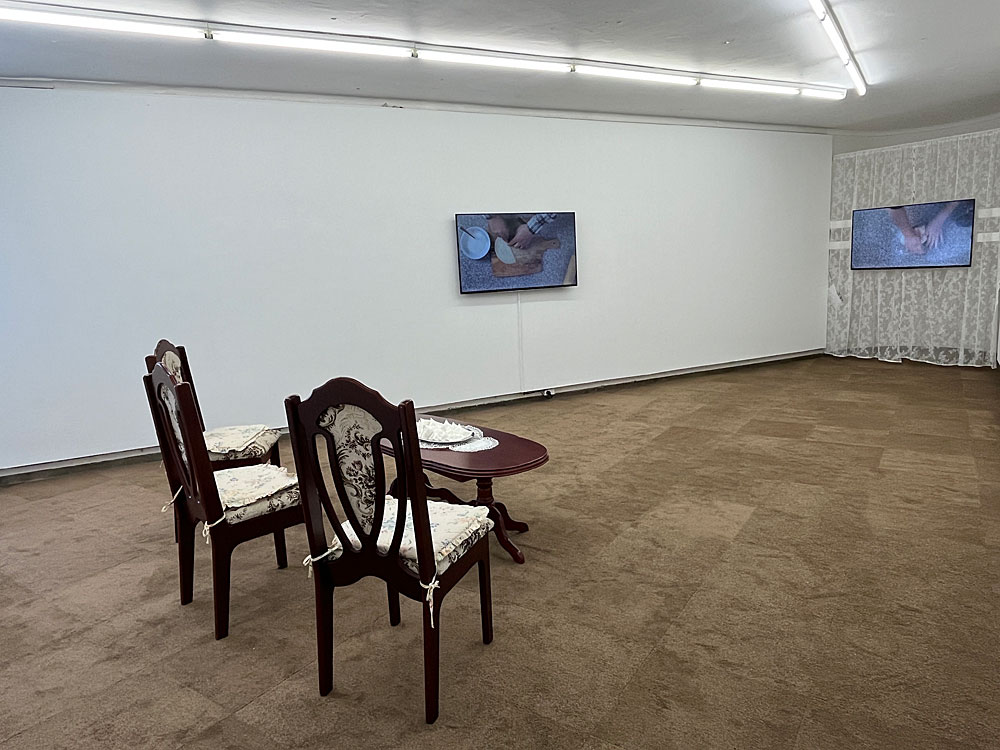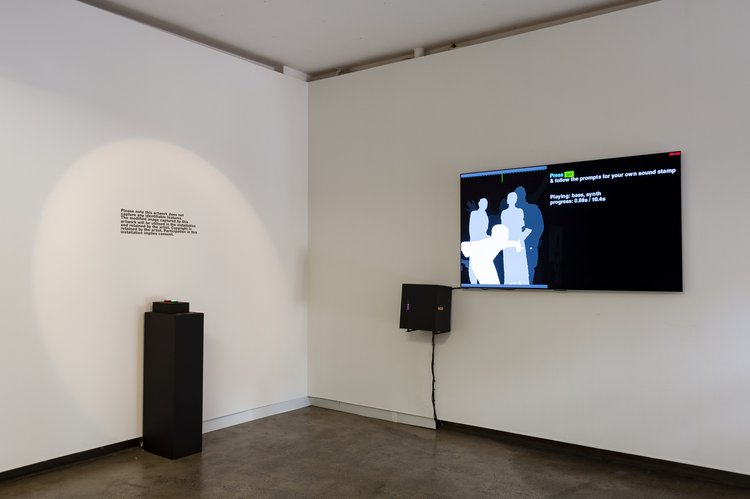Writing outcome from the Firstdraft Writers Program (2022-23).
View on the Firstdraft website: https://firstdraft.org.au/writers-program-2024/feeling-images-and-sensing-words.
This project experiments with synaesthetic writing to test the potential of language to express the perceptual qualities present in multisensory art encounters.(1) Following the increased reliance on web-based media to present contemporary art during the COVID-19 pandemic, the project responds to the growing demand to develop and expand the ways institutions represent and describe artworks online.
I began thinking about the sensory information omitted from web-based documentation of artworks in 2021 after seeing photographs of two scented artworks. First is a photograph of artist and curator Eleanor Zurwoski’s collaborative work That Feeling of Being Kneaded (2019) in the exhibition materials for A call to rise (2021) at Firstdraft, Gadigal land/Sydney.(2) Zurwoski’s installation includes a jar containing a live, 14-year-old sourdough starter. Having spent the previous year nurturing my own starter throughout successive COVID-19 lockdowns, memories from my own lived experience supplied the sour yeasty smell that was sure to accompany the installation. In this instance, my sense of sight intercommunicated with my sense of smell to furnish the missing sensory aspects of the artwork, thus highlighting the important role memory plays in perception.
Second is artist Brydie Greedy’s MFA work in the 2021 Postgrad Show at the National Art School (NAS). The photograph posted by NAS depicts a white cloud suspended in the middle of a gallery space amongst curved stretched canvases.(3) The caption simply describes it as an immersive scent installation and notably omits details about the sensory experience of the work. I was left wondering what it smelled like and if it involved other sensory impressions when walking through the mist. Could you feel droplets on the skin? Did it feel wet or cold? Did the scent linger on the body throughout the rest of the day? Did the cloud billow and move, swirling around and away from bodies as audiences moved through the space? Or was the artwork largely invisible when near, like the way flying through clouds causes them to disappear?
With these questions in mind, I became curious to see if language could be used to convey the haptic, sonic, olfactory, and gustatory dimensions of art. Thinking about how a description of a meal can cause one’s mouth to salivate or how an image of food can invoke an impression of its taste, I set out to explore the potential of synaesthetic perception to produce cross-modal correspondences (or intercommunication) between the senses as a means to facilitate a deeper understanding of an object. Artists experimenting and exhibiting multisensory art expand the parameters of art beyond visual experience alone. The active participation required for the perception of sensory art practices configures the viewer as embodied; audiences are not merely seeing the artwork but tasting, touching, smelling, and sometimes hearing the materials that make up the work.
I began by researching the application of creative language in audio descriptions to make images accessible to audiences who cannot visually perceive them. When drafting text to describe art for audiences who are blind, partially sighted, or who have low-vision, writers sometimes use similes and poetic language to draw comparisons and vivify the art forms. For example, by describing the colours of orange, yellow, or green as citrusy, one can get a sense of the brightness of the hue by correlating it with the acidic taste. Similarly, describing grey as smoky grey can evoke a multitude of sensations; the light brush of a wisp of smoke, the suffocating miasma of thick choaking smog, or the acrid smell of bushfires. Important to this form of descriptive language is the reader’s prior experience, if they do not have a sensory-related memory of a citrusy taste or smell of smoke, the expressive comparisons do not contribute toward their perception of the artwork.
The senses also have the potential to intercommunicate in a phenomenon is known as synaesthesia; a condition whereby the stimulation of one sense can involuntary trigger an unrelated sensory reaction. Philosopher André Abath makes a distinction between what he calls ‘synaesthesia proper’ and ‘sensory union’. To define synaesthesia proper, Abath cites the work of neurologist Richard Cytowic who describes the phenomenon as “the rare capacity to hear colors, taste shapes, or experience other equally startling sensory blendings whose quality seems difficult for most of us to imagine.”(4) Notable in this form of synaesthesia the arbitrariness of the sensory blending. There are no conventions or formulas to chart the sensory blendings of synaesthesia proper, each sensory linkage is unique to the individual.
Abath’s second form of synaesthesia, called ‘sensory union’, is a relatively commonplace occurrence. To describe sensory union, Abath gives examples of our tendency to correlate certain colours as warmer or cooler (a union between sight and touch) or the sound of words like ‘bouba’ or ‘kiki’ with rounded or jagged shapes respectively.(5) In the literary arts, this is known as linguistic or metaphorical synesthesia. By focusing on sensory language that speaks to the five human senses and by combining the descriptive words to generate synaesthetic pairings like ‘chilly gaze’ or ‘loud colour’, the following two case studies will seek to generate cross-sensory exchanges through the written descriptions.

Case Study 1: Monica Rani Rudhar, I Cook A Lot Of All These Foods (2022)
Sensory keywords: scratchy, cushioned, hushed, toasty, spicy, earthy, pristine, quiet, muted, symmetric, warm, astringent, camphoric, formal, soft, pale, homely, mottled, ornate, resplendent, spacious, tapering, triangular, stillness, static
Synaesthetic pairings: warm earthy (touch – smell), quiet formality (sound – vision), hushed softness (sound – touch), mottled perfume (vision – smell), gentle murmur (touch – sound)
Audiences enter Monica Rani Rudhar’s full-room installation, I Cook A Lot Of All These Foods (2022), shoeless, the soles of their feet receptive to the texture and sensations of the stiff carpet fibres. A hushed softness blankets the room, the lace curtains admitting a diffused light and the gentle murmur of voices and sounds of food preparation filling the space. The polished wood furniture lends a quiet formality to the domestic scene, and the scent of toasted spices hangs in the air, the warm earthy smell forming a mottled perfume with the odour of mothballs.

Case Study 2: erincox and blackwd, Our bodies are the instruments (2022)*
* Notably, the artist statement for Our bodies are the instruments addresses the correlation between sound and shape: “Many of us relate sounds with shape and size, envisioning deep bass sounds with larger forms and high sharp sounds with slight.”(6)
Sensory keywords: tinkle, loud, cacophony, din, dissonance, echo, angular, radiating, rippling, shimmer, sparkly, harmonic, pinging, singing, vibrating, shifting, reverberation, strumming, throbbing, streaming, flowing, still, frozen
Synaesthetic pairings: frozen pose (touch – vision), shimmering harmonies (vision – sound), rippling dissonance (vision – sound), twinkling vibrations (sound – touch)
The bodies filtered and processed through erincox and blackwd’s algorithm in Our bodies are the instruments (2022) generate twinkling vibrations that enable audiences to hear and feel their three-dimensionality. After pressing a glowing green button, subjects move into position while a camera digitally captures their silhouette. The screen, revealing their frozen pose, depicts the sonified data running like raindrops along the contours of their digital body. The score shifts from shimmering harmonies to a rippling dissonance as the digitised notes hit the contorted figures.
(1) This paper draws on research about synaesthesia and the senses from my PhD. See Megan R. Fizell, “Gastronomic Body: Sensory and sociocultural dimensions of food art,” (PhD dissertation, University of New South Wales, Sydney, NSW, Australia, 2021).
(2) Hannah Jenkins, “Making and breaking bread with Eleanor Zurowski,” Firstdraft, accessed 11 June 2021, https://firstdraft.org.au/news/making-and-breaking-bread-with-eleanor-zurowski.
(3) National Art School (@nas_au), “As part of The Postgrad Show 2021, MFA student Brydie Greedy (@greedy________) is presenting a multi-sensory experience throughout the duration of the exhibition,” Instagram, 24 January 2022, accessed 24 January 2022, https://www.instagram.com/p/CZF7616vnqN/.
(4) Richard Cytowic, quoted in André J. Abath, “Merleau-Ponty and the Problem of Synaesthesia,” in Sensory Blending: On Synaesthesia and related phenomena, ed. Ophelia Deroy (Oxford: Oxford University Press, 2017), 152.
(5) Abath, “Merleau-Ponty and the Problem of Synaesthesia,” 152.
(6) “A(Di)pology,” Firstdraft, accessed 16 December 2022, https://firstdraft.org.au/s/2022-Roomsheets_LGFAC_Updated.pdf.

1 comment
Firstdraft Writers Program 2022-23 | Megan R. Fizell | Art Historian & Theorist says:
Sep 24, 2023
[…] Feeling images and sensing words (2023). […]